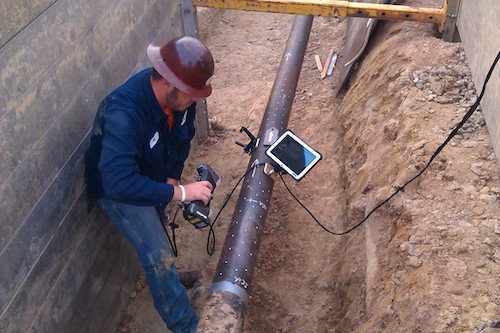NOTE: The sponsor of this content may contact you with more information on this topic. Click here to opt out from sharing your email address with this sponsor. By submitting your email address, you will NOT be unsubscribing from the BIC Magazine Industry Connection e-newsletter or any other BIC Alliance email list.
Introduction
Integrity engineers, maintenance managers and operators of pipelines, refineries, chemical plants, and storage facilities are all facing increasing pressure from regulatory authorities and environmental groups to guarantee the integrity of their pipeline networks and process operations. New 3D scanning technology can save time and increase the accuracy of both data acquisition and integrity analysis, and dramatically improve the inspection process to identify and correct unsafe conditions that could cause a catastrophe.
General Definition
3D scanners are still considered as new tools in pipeline integrity assessment. They are very effective solutions compared to conservative calculation methods. In fact, the amount of information gathered by a 3D scanner makes it suitable for sophisticated assessments, providing local depth readings more precisely to indicate whether a pipe segment is fit for service.
3D scanners are tri-dimensional measurement devices used to capture real-world objects and environments so they can be remodeled and analyzed in the digital world. In this article, the term 3D scanner refers to the non-contact measurement process between the device and the physical part. 3D scanners are, from a macro point of view, 2D cameras from which a complete 3D model of an object can be extracted using picture registration and triangulation.

3D Assessment: How Does It Work?
Scanned surfaces can directly be used in procedures for assessments of pressurized components subject to local metal loss from corrosion, erosion or both. Surface information extracted from the scan data provides sufficient information to quantify a component for continued operations or rerating. Damage caused pitting, mechanical issues or blend grinding that exceeds corrosion allowance can also be evaluated using 3D scanners in conjunction with the same assessment procedure.
Metal loss assessments can be based on different industry codes and standards. Traditionally corrosion assessment techniques reside on thickness profiles. Pit gauges are generally used for these types of assessments. A 3D scanner that can gather significant amounts of points per second is the ideal tool to maximize result accuracy, field efficiency and conservative assessments. The ultimate goal is to determine the Maximum Allowable Operating Pressure (MAOP) or Maximum Fill Height (MFH) for tank.
Extracting the critical thickness profile is one of the most time-consuming operations during the assessment process and such operations can directly be affected by a technician’s skills. When using 3D scanners, users can capture the entire metal loss area and parent material surrounding the localized corrosion faster and more easily. When combined with pipeline integrity assessment software, 3D scanners can automatically identify critical thickness profiles and outline the minimum thickness found on the scan data. This is a tremendous time saver for both data acquisition and integrity analysis.
Handling Data with “Training-free” Software
To get the maximum benefits out of a 3D scanner, it’s important to use the right tool to extract the information from the 3D model. To accomplish this, a new generation of software was initially developed in 2011. This software is application-specific and guides you through the right process to perform code-compliant assessments. Different than general 3D software, this new kind of software is configured based on user requests. For example, parameters that need to be set will be different if a customer wants to perform material loss assessment instead of mechanical damage analyses.
By removing the complexity for high-density data handling and focussing on the application itself, recent integrity software gives direct access to advanced assessment techniques for better decision making. A great example of this comes from the mechanical damage assessment: it has never been easier to perform strain-based assessment.
ILI CORRELATION: CLOSE LOOP WITH DIRECT AND INDIRECT ASSESSMENT TECHNIQUES
Although ILI tools are a great way to detect potential problems before any serious consequences, they are not always good at finding particular types of defects. There are millions of miles of pipelines in the world: improving sensitivity and reliability of these non-destructive tools is crucial for public safety.
To help understand the real performances of the tool, results extracted from 3D scanners can be correlated to pig data. This correlation is usually performed by looking at a number only. With the right integrity software, it’s possible to display in 3D that correlation prior exporting unity chart.
WORKING WITH 3D SCANNERS WHERE TRADITIONAL TECHNIQUES CAN’T
During construction, when there are no obstacles, building a straight pipeline is usually the way to go. However, there can be crossroads, rivers, buried or above-ground structures that create the needs for field bends. As pipes have a certain amount of flexibility, they can be gently turned. Sometimes, several successive bends are required to go around an object. When corrosion is found in a sharp bend, conventional pit gauge techniques cannot work. In these cases, assessments are generally based on the UT technique. Integrity software can take 3D scanners data and straighten it, maintaining the benefits of speed and high resolution data of the 3D scanners.
Applicability and Limitations
Major causes of oil or gas spills can be listed in different categories. 3D scanners can generally help to assess damage caused b corrosion (external and internal) and in cases of mechanical damages. That type of damage is usually the result of natural hazards, excavators or agricultural activities.
All assessment procedures that were developed to evaluate the pressure boundaries of pressure vessels, boiler components, piping, and shell courses of storage tanks with a flaw resulting from single or multiple damages can benefit from 3D scanners. These tools can also help for the assessment of non-pressure-boundary components such as supports.
Even components that have not been designed or manufactured to original design criteria can be analyzed with a 3D scanner to identify metal loss that can occur over a specific period of time. Several tools are available to compare scans of the same component at different times. Such procedures can be extremely useful for corrosion management.
The main limitation of all 3D scanners comes from basic optical rules. These scanners can only digitize the exposed surfaces. This is true for laser-based 3D scanners and structured-light technologies.
What is the Future of Integrity Assessment?
One thing for sure is that 3D assessments are not going away any time soon. We are at the beginning of a new era. Older, conventional methods will be slowly replaced by new technologies. Now it’s time for 3D scanners to perform corrosion and mechanical damage assessments. Moreover, 3D scanners will continue to evolve. The scanners that pipeline companies have started to use right now are not the ones they will use in five years.
Following this technological evolution, there will be a software revolution to support the need for simplicity. Application-oriented software will continue to grow to offer faster, better and more accurate results to pipeline integrity engineers.
A great example of this evolution has already started with advanced NDT integrity software, which combines multiple NDT technologies. Since every NDT technique has its own strengths and weaknesses, being able to merge measurement results from the best 3D scanner in the world with the most sophisticated UT measurement techniques is a real game changer! Integrity engineers will benefit from the most accurate and actionable information available to make informed decisions and ensure public safety.
Many NDT manufacturing companies invest a lot of money in research and development to innovate and solve UT challenges (e.g., external metal loss); however, concrete solutions are available today to make safer decisions.
Conclusion
3D scanners are used for pipeline fitness-for-service evaluations and replace conventional methods, such as pit gauges and ultrasound probes. Corrosion and mechanical damage can now be characterized with very high accuracy and repeatability. The development of 3D technologies in the market has definitely set a new standard for integrity work in the pipeline industry. They are great tools and provide safest way for integrity engineers and pipeline companies to assess the health of their networks.
Jérôme-Alexandre Lavoie
Product Manager, Creaform
Bio of the author:

Jérôme-Alexandre Lavoie joined Creaform in 2007 as an application engineer. After four years of working closely with customers, he became product manager with the mandate to develop Non-Destructive Testing solution. He is now in charge of multiple products in various market including NDT, Quality Control and Automated Quality Control. He holds a physical engineering degree form Laval University in Quebec.
